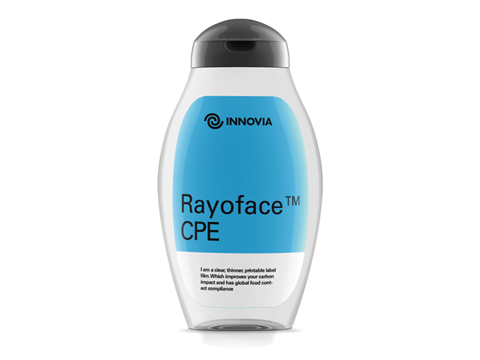
At Labelexpo 2023, Innovia Films has launched two new, designed-for-recycling label facestock films – reported to be thinner than traditional filmic label materials, naturally printable, and capable of reducing customers’ carbon footprints.
The Rayoface CPE45 and WPE45 films are clear and white, respectively, and seek to replace PE and MDO films in the home and personal care sectors. Using CPE and WPE films is said to carry over the label dispensing speeds of bubble-produced films by maintaining their high machine direction stiffness.
Developed through material science by Innovia Films’ scientists, both films are fully and immediately available.
“In the Home and Personal Care arena, clear and white polyethylene label facestock films are routinely used, but these can be replaced by CPE and WPE, which have many advantages over them,” says Alasdair McEwen, product manager Labels and Graphics at Innovia Films. “CPE and WPE are approximately 40% thinner than the polyethylene films used, meaning you can use a label that is much thinner, and most importantly using less of the planet’s scarce fossil resources.
“CPE also has outstanding clarity and very low haze compared to a polyethylene label, making it perfect for use on clear-on-clear applications on PET bottles.”
“This has been an extremely important development for Innovia,” adds Lucija Kralj, Business Unit Director Labels. “It is vital with any new products that we launch, that they align with the markets move to packaging materials that will meet design for recycling guidelines, and CPE and WPE do just that.
“Alongside that, these films give our customers not only the ability to significantly downgauge, but also improve their carbon footprint.”
Lecta is also displaying its sustainability-minded facestock products alongside release liners, solutions for pressure-sensitive applications, and more.
Additionally, the collaborative #SleeveConnect project – featuring EMSUR, Siegwerk, Karlville, and SK microworks – has resulted in a CPET shrink sleeve label for colourless rPET bottles in the hopes of achieving a fully recyclable packaging solution.
If you liked this article, you might also enjoy:
The Lidl approach to packaging sustainability
How did Brazil achieve its 100% aluminium can recycling rate – and can it be replicated in the EU?
Experts have their say on the EU’s Packaging and Packaging Waste Directive revisions
A deep dive into the most important packaging sustainability trends and solutions


















No comments yet